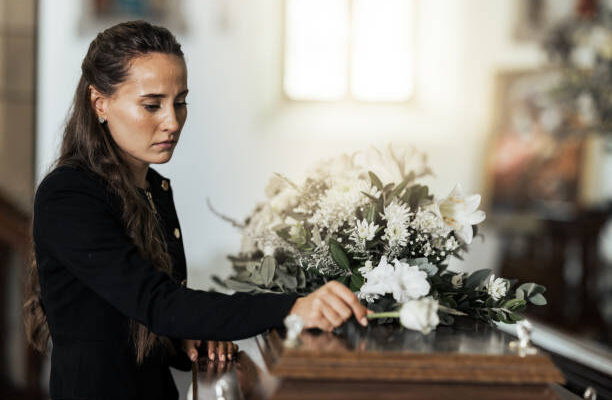The human experience is a tapestry woven with threads of joy and sorrow, love and loss. One of the most profound and challenging aspects of our journey is the experience of losing a loved one. The pain of grief is a universal human emotion that transcends cultural boundaries and societal norms. However, amidst the shadows of sorrow, a glimmer of light often emerges as individuals navigate the intricate path of love after someone dies.
The Complexity of Grief
 (Photo from iStock)
(Photo from iStock)
Grief is a multifaceted and dynamic process, unique to each individual. It is not a linear journey but rather a roller coaster of emotions that can leave us feeling overwhelmed and disoriented. The initial shock of loss can be paralyzing, and the weight of grief can seem insurmountable. Yet, as time unfolds, the emotional landscape shifts, and the process of healing begins.
-
Embracing the Pain:
The first step towards love after loss is acknowledging and embracing the pain. Grieving is not a sign of weakness but a testament to the depth of love shared. Allowing oneself to feel the raw emotions – the anger, sadness, and emptiness – is crucial in the healing process. By confronting the pain head-on, individuals open the door to self-discovery and resilience.
-
Finding Support:
Grief is a journey that should not be travelled alone. Seeking support from friends, family, or support groups can provide solace and understanding. Sharing memories and emotions with others who have experienced similar losses fosters a sense of connection and reassures grieving individuals that they are not alone in their struggle.
-
Love Transcends Death:
While the physical presence of a loved one may be gone, the love that existed endures beyond the boundaries of life and death. The essence of love transcends the mortal coil, leaving an indelible mark on the hearts of those left behind. Understanding this eternal aspect of love can be a source of comfort and inspiration.
-
Cherishing Memories:
One way to keep the flame of love alive is by cherishing and celebrating the memories shared with the departed. Creating a memorial, organizing a tribute, or simply revisiting old photographs can be therapeutic and provide a tangible connection to the person who has passed away.
-
Continuing Bonds:
Psychologist J. William Worden introduced the concept of “continuing bonds,” emphasizing that maintaining a relationship with the deceased is a healthy and natural part of the grieving process. This can take various forms, such as talking to the departed, keeping symbolic mementos, or finding ways to honour their legacy through acts of kindness and charity.
Rediscovering Life
 (Photo from iStock)
(Photo from iStock)
As the journey through grief progresses, individuals often find themselves at a crossroads – a point where they must choose to continue living and embrace the possibility of love after loss.
-
Rebuilding Identity:
The death of a loved one can shatter the sense of self, leaving individuals questioning their identity and purpose. Rediscovering life involves a process of rebuilding, a journey of self-discovery that allows individuals to redefine who they are in the absence of their loved one. This may involve pursuing new interests, rekindling old passions, or embarking on a journey of personal growth.
-
Opening the Heart to New Connections:
While the love for the departed remains eternal, there is space in the heart for new connections. Opening oneself to the possibility of new relationships and friendships is a courageous step towards embracing life after loss. It does not diminish the love for the person who has passed away but acknowledges the resilience of the human spirit to heal and love again.
-
Honouring the Past, Embracing the Future:
Navigating the path of love after someone dies is a delicate dance between honouring the past and embracing the future. It requires a balance between preserving the memory of the departed and forging ahead with newfound strength and purpose.
-
Rituals and Traditions:
Establishing rituals and traditions to honour the memory of a loved one can be a comforting way to maintain a connection with the past while navigating the present. This may include annual memorial gatherings, lighting candles, or participating in activities that held significance to the departed.
-
Embracing Growth:
As individuals move forward in their journey, personal growth becomes a testament to the strength cultivated through grief. The challenges faced during the grieving process shape individuals into more compassionate, resilient, and empathetic beings. Embracing growth is not a betrayal of the past but a testament to the transformative power of love and loss.
Conclusion
Love after someone dies is not a static concept but a dynamic, evolving process. It is a testament to the resilience of the human spirit and the enduring nature of love. Grief, though painful, has the power to transform, leading individuals on a journey of self-discovery and healing. As we navigate the intricate tapestry of love after someone dies. We find solace in cherishing memories, continuing bonds, rediscovering life, and honouring the past while embracing the future. In the end, love transcends the boundaries of mortality, leaving an everlasting imprint on the hearts of those who dare to love and remember.
In the tapestry of life, the threads of love after loss are interwoven with strength and resilience. Cherishing the memories becomes a source of comfort, a balm for the soul. That allows the departed to live on in the hearts of those left behind. Continuing bonds with the deceased brings a sense of connection that transcends the physical realm. Fostering a profound understanding of the enduring nature of love. As individuals rebuild their identities and rediscover life. They open their hearts to new connections, acknowledging the capacity to love again. The journey of love after someone dies is not about forgetting but about honouring the past while embracing the limitless possibilities that the future holds. Further, a testament to the indomitable spirit’s ability to find hope and joy even in the face of profound loss.




